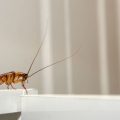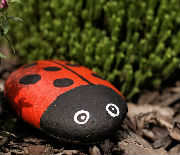Image by: allispossible.org.uk / License: BY 2.0
Although more rare than cockroaches or rodents, woodworms are amongst the most destructive household pests.
Homeowners, who have been unlucky enough to experience woodworm infestations know how hard it is to get rid of those pesky invaders and how the damage they do is often beyond any repair.
That’s why it is crucial to understand the common reasons why woodworms might infest your home and how to prevent something like this in the first place.
Table of Contents
What is a woodworm?
Woodworm is a collective term given to the wood-boring larvae of several species of beetles, the most famous of which is the Deathwatch beetle.
The most common woodworm that is infesting furniture in the UK is the Common Furniture Beetle (Anobium punctatum). It primarily targets softwoods and causes small, round exit holes in the wood.
What does a woodworm beetle look like?
A woodworm beetle is a small insect, usually brownish or black, with a cylindrical body about 2-5mm long. The most common type, the Common Furniture Beetle, has a slightly humped back and a texture that looks kind of dusty.
Check also: Most Common Wood Boring Insects in the UK
What causes woodworm to appear?
As with almost all insect larvae, these “worms” thrive in warm, humid conditions and prefer the hospitality that rotten timber offers.
Damp environments, caused by leaks or bad insulation, can quickly cause the wood to decay, and it won’t be long before woodworms settle in.
Fungal problems, such as mould and mildew, only make matters worse as they weaken the structure of the wood and make it easier for the woodworm larvae to burrow deeper.
Another common reason for the infestations is keeping infested wooden material on your property. This includes not only driftwood and firewood but also untreated furniture items, chattels, and even structural elements.
Signs of woodworm in furniture
Okay, so how to discover woodworm in furniture? The most obvious signs of a woodworm infestation in your wooden furniture include:
- an often visible darkening of the colour
- lots of holes in the wood
- a cracking sound coming from the furniture
- adult beetles nearby
Want to know more about their larvae? Check our in-depth entry on woodworms at our Pest Library!
How to tell if a woodworm is active?
There exists the general misconception that once you see the holes in the wood, it means the woodworm has grown up and has left the nest.
And in most cases, this is true. However, the same now grown-up beetle might come back and lay eggs in the place it once called home. As a result, your furniture will turn into a breeding ground for these pesky insects.
What you should be looking for instead is an adult carcass, or freshly ejected frass, and also check the number and density of the holes.
What is the difference between woodworm and termites?
Termites and woodworms both eat wood and are equally devastating, but making a difference between the two is the first step towards coming up with the appropriate solution.
The first difference stems from the fact that woodworm is the larvae of specific types of beetles, while termites are very social cockroaches that live in colonies.
Unlike woodworms, termites do not bore visible holes in wooden furniture, which is why it’s harder to detect them until there are more obvious signs.
Are you dealing with a pest infestation?
You don't have to be alone in the battle against pests. Hire a professional pest expert!
Call usHow to treat woodworm in furniture
Follow the steps below to kill woodworm in furniture:
- Step 1. Scan the damages. First, you need to be sure you’re dealing with a woodworm. Are there any holes? Do you hear the occasional cracking sound from your furniture? If yes, here’s what you should do next.
- Step 2. Determine whether the furniture can be saved. Most of the time, the woodworm would be eating the upper layers of the wood furniture, leaving the core and possibly even the surrounding areas untouched. This way, you’ll only need to treat the specific spot. However, if the structure seems weak, it might be better to simply throw it away.
- Step 3. Purchase a commercial woodworm treatment solution containing Permethrin. The product solutions you’ll find on the market today come in large tubes and are highly concentrated. Some you will need to dilute with water, and some not. Read the label carefully before use. Some products are for a specific type of woodworm, while others are universal. If you are not sure what product to buy, you can consider booking an inspection and having your timbers treated professionally.
- Step 4. Wear protective gear. You’ll need to put on a gas mask since you’ll be working with a toxic chemical.
- Step 5. Remove the finish and paint. Get some sandpaper and sand the infested section of your furniture piece. Any kind of finish or paint should be removed before applying the product.
- Step 6. Spray the solution over the damaged area. This will kill anything living inside. Recoat the surface of the damaged wood.
Check also:
Home remedies to eradicate woodworm
If you’re looking for a more practical and natural solution to eliminate woodworm, the following home remedies may be of help.
Fresh Acorns
Since the scent of fresh acorns is quite attractive to these insects, you can take a few and wrap them in a cloth. When the breeding season begins, adults lay their eggs on the cloth, and their larvae eat the acorns as they grow.
After the warm months of the year (the time during which the woodworm reproduces) are over, the cloth and its unpleasant occupants can be disposed of.
Even though it is quite a slow method, it is effective as a complement to other treatments, and it can even be used as prevention.
Plastic Cover
Another trick that works well to remove woodworm is to cover the furniture or affected pieces with plastic, leaving a small hole through which a little insecticide can be sprayed. Despite its simplicity, this technique is extremely effective.
How to protect furniture from woodworm
Choosing a conventional pest control product is recommended for anyone who decides to deal with this problem on their own. Sure, they are costly, but they are your best chance of treating the infestation.
But if you prefer to make your own solution, then here is a natural woodworm control method you can try.
DIY woodworm treatment
The first thing you must do is keep the room temperature dry as humidity attracts the beetles very easily.
Next, you need to melt beeswax and tint it into the colour of the wood, enough to fill in the holes. This method is sure to work, as woodworms hate beeswax. However, it’s not a long-term solution.
Alternatively, you may conceal the damage with ‘wood putty.’
Put sawdust into a cup and stir it together with wood glue until everything becomes a paste. Smear the mixture into the holes and immediately wipe away with a damp cloth. Let it dry out.
And, even if the woodworm is successfully eradicated, it would be a good idea to treat the rest of your wooden furniture with the same solution. The beetle might have simply left through the window, so pre-treat your remaining possessions just to be sure it doesn’t find itself a new nest.
Keep in mind that woodworm treatment specialists know how to deal with woodworm infestations a lot faster and easier.
Frequently asked questions about woodworms in furniture
Is treating woodworm with WD40 possible?
Let us assure you that this is not an effective treatment for woodworm. Simply because it doesn’t penetrate deep enough into the wood to reach the larvae and kill it, which is the real problem. For proper treatment, you’d need a specialised woodworms insecticide.
Is treating woodworm with vinegar possible?
Actually, vinegar is not an effective treatment for woodworm contrary to what some might say. While it might kill some adult beetles on the surface, it won’t reach the larvae inside the wood.
Can woodworm in furniture spread?
Yes, woodworm can spread to other wooden items in your home. The larvae can burrow into the wood and can move to nearby pieces, leading to a larger infestation. So it is best to take action immediately when you notice signs of woodworm.
What attracts woodworm to furniture?
Woodworms are attracted to damp or untreated wood, especially in older or antique furniture. High humidity levels and softwood are particularly appealing to them.
Header image source: Levente Nuber/shutterstock.com











Really informative post! I got all the useful information in this blog.
I have been reading about bed bug re emergence for about ten years, I have been using DE around the house for years as a preventative measure, if I do happen to bring some home they dont stand a chance. I also place the sticky traps arond the bed and hang sections of clear contact paper around, I find the occasional gnat, mite or springtail but so far no bedbugs.
Hi my name is Edna l have small holes in bedroom furniture worried to death in case it’s wood worm